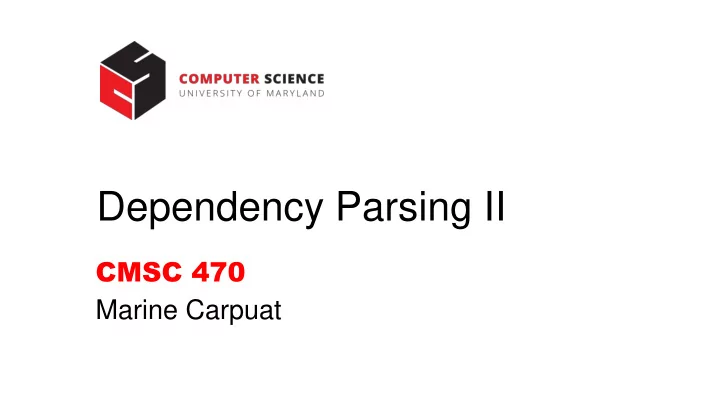

Dependency Parsing II CMSC 470 Marine Carpuat
Arc Standard Transition System defines 3 transition operators [Covington, 2001; Nivre 2003] SHIFT • Remove word at head of input buffer • Push it on the stack LEFT-ARC • create head-dependent relation between word at top of stack and 2 nd word (under top) • remove 2 nd word from stack RIGHT-ARC • Create head-dependent relation between word on 2 nd word on stack and word on top • Remove word at top of stack
Transition-based Dependency Parser Properties of this algorithm: - Linear in sentence length - A greedy algorithm - Output quality depends on oracle
Research highlight: Dependency parsing with stack-LSTMs • From Dyer et al. 2015: http://www.aclweb.org/anthology/P15-1033 • Idea • Instead of hand-crafted feature • Predict next transition using recurrent neural networks to learn representation of stack, buffer, sequence of transitions
Research highlight: Dependency parsing with stack-LSTMs
Research highlight: Dependency parsing with stack-LSTMs
An Alternative to the Arc- Standard Transition System
A weakness of arc-standard parsing Right dependents cannot be attached to their head until all their dependents have been attached
Arc Eager Parsing • LEFT-ARC • Create head-dependent rel. between word at front of buffer and word at top of stack • pop the stack • RIGHT-ARC • Create head-dependent rel. between word on top of stack and word at front of buffer • Shift buffer head to stack Move dependent word to stack (so it • SHIFT can serve as head of other words) • Remove word at head of input buffer • Push it on the stack • REDUCE • Pop the stack Pop words off the stack once they have been assigned all their dependents
Arc Eager Parsing Example
Properties of transition-based parsing algorithms
Trees & Forests • A dependency tree is a graph satisfying the following conditions • Root • Single head • No cycles • Connectedness • A dependency forest is a dependency graph satisfying • Root • Single head • No cycles • but not Connectedness
Properties of the transition-based parsing algorithm we’ve seen Soundness: For every complete transition sequence, the resulting graph is a projective dependency forest Completeness: For every projective dependency forest G, there is a transition sequence that generates G If we really want a tree rather than a forest, we can use a trick: add links to ROOT from disconnected trees
Projectivity • Arc from head to dependent is projective • If there is a path from head to every word between head and dependent • Dependency tree is projective • If all arcs are projective • Or equivalently, if it can be drawn with no crossing edges
Is this tree projective?
Is this tree projective?
Projectivity • Arc from head to dependent is projective • If there is a path from head to every word between head and dependent • Dependency tree is projective • If all arcs are projective • Or equivalently, if it can be drawn with no crossing edges • Projective trees make computation easier • But most theoretical frameworks do not assume projectivity • Need to capture long-distance dependencies, free word order
Arc- standard parsing can’t produce non - projective trees
How frequent are non-projective structures? • Statistics from CoNLL shared task • NPD = non projective dependencies • NPS = non projective sentences
How to deal with non-projectivity? (1) change the transition system • Intuition • Add new transitions • That apply to 2 nd word of the stack • Top word of stack is treated as context [Attardi 2006]
How to deal with non-projectivity? (2) pseudo-projective parsing Intuition • “ projectivize ” a non - projective tree • by creating new projective arcs that can be transformed back into non- projective arcs in a post- processing step
Dependency Parsing: what you should know • Transition-based dependency parsing • Shift-reduce parsing • Transition systems: arc standard, arc eager • Oracle algorithm: how to obtain a transition sequence given a tree • How to construct a multiclass classifier to predict parsing actions • What transition-based parsers can and cannot do • That transition-based parsers provide a flexible framework that allows many extensions • such as RNNs vs feature engineering, non-projectivity (but I don’t expect you to memorize these algorithms) • Next: Graph-based dependency parsing
Graph-based Dependency Parsing Slides credit: Joakim Nivre
Directed Spanning Trees
Dependency Parsing as Finding the Maximum Spanning Tree • Views parsing as finding the best directed spanning tree • of multi-digraph that captures all possible dependencies in a sentence • needs a score that quantifies how good a tree is • Assume we have an arc factored model i.e. weight of graph can be factored as sum or product of weights of its arcs • Chu-Liu-Edmonds algorithm can find the maximum spanning tree for us • Recursive algorithm • Naïve implementation: O(n^3)
Chu-Liu-Edmonds illustrated (for unlabeled dependency parsing)
Chu-Liu-Edmonds illustrated
Chu-Liu-Edmonds illustrated
Chu-Liu-Edmonds illustrated
Chu-Liu-Edmonds illustrated
Chu-Liu-Edmonds algorithm
For dependency parsing, we will view arc weights as linear classifiers Weight of arc from head i to dependent j , with label k
Example of classifier features
Typical classifier features • Word forms, lemmas, and parts of speech of the headword and its dependent • Corresponding features derived from the contexts before, after and between the words • Word embeddings • The dependency relation itself • The direction of the relation (to the right or left) • The distance from the head to the dependent • …
Recommend
More recommend